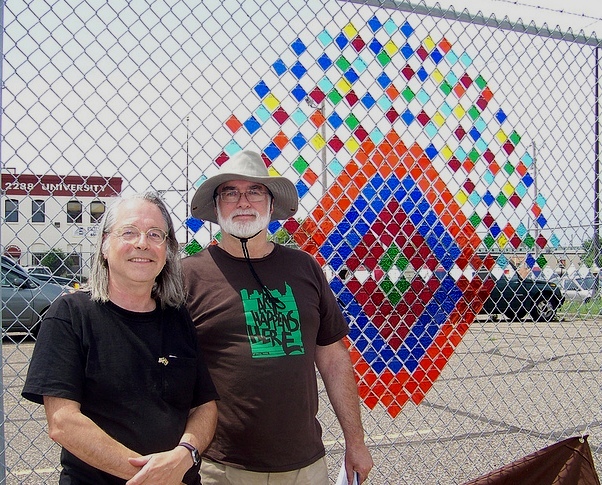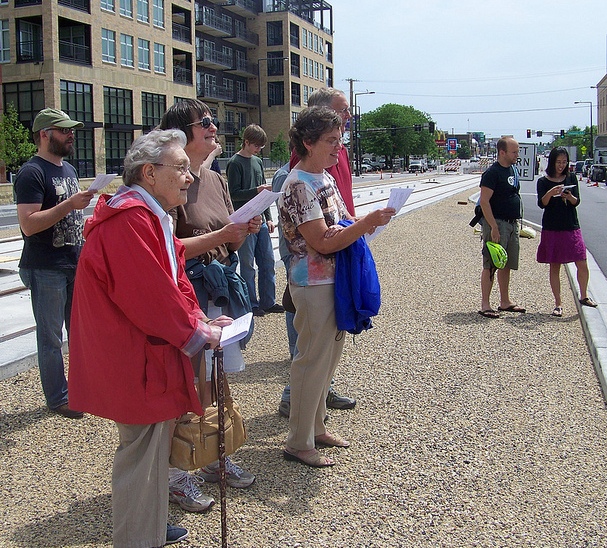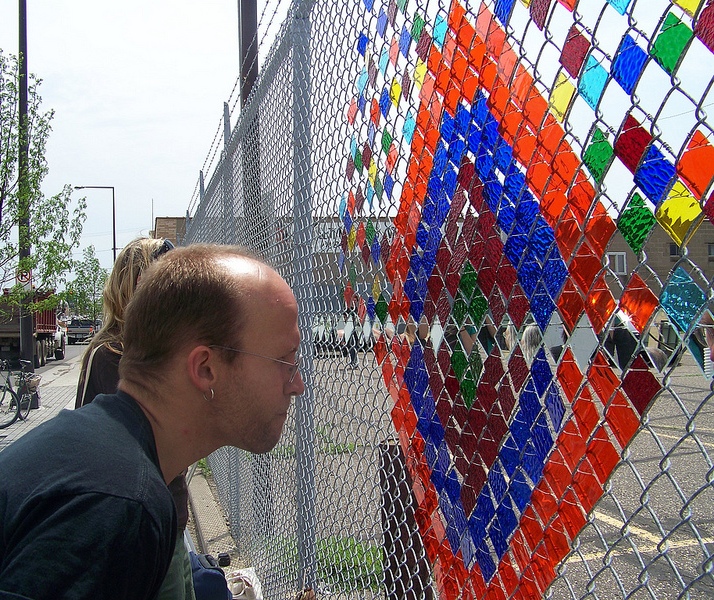
Artist Steve Bougie makes a delicate community offering
Last Wednesday over the lunch hour, I attended a small but lively unveiling ceremony for a public art project, a bit of “placemaking” on University Avenue in St. Paul. Glass artist Steve Bougie, with the assistance of apprentice Richard Fuller, adorned an otherwise unremarkable stretch of chain-link fence around a parking lot with a “chained-glass design” of their own making.
The project was sponsored by Irrigate (a public/private partnership that includes the Knight Foundation) and Arcadia Management (owners of Carleton Artist Lofts and a neighboring apartment building, The Lyric, as well as said fenced lot, just across the street). Bougie’s “chained-glass” piece is also situated alongside the light rail route, just next to a station. Bougie says, “I used to work in the building across the street; I looked at this lot every day out my window. I just wanted to take an ordinary spot, something you see all the time and take no note of, and make something extraordinary there.” He says, for him there’s an element of “sacrament” to this kind of work; the artist describes the piece as an offering of sorts to his old neighborhood, a little something to brighten the days of the people who live and work there.
Bougie fabricated each of the brightly colored squares of glass that comprise the work – vivid cobalt, aquamarine, green, yellow, red and orange to catch the sunlight. The two artists spent close to eight hours anchoring the glass, square by square, within the chain-link fence. The design suggests a paddle-wheel (a familiar nautical motif in our water-rich state’s history); it was chosen to echo a similar mural planned for the light rail station adjacent to the lot.
Seeing the paddle-wheel piece got me thinking: Remember the “broken windows theory” of urban decay? Rooted in research conducted in Newark, New Jersey by social scientists George Kelling and James Q. Wilson, the theory was first espoused in a 1982 article for “The Atlantic;” their ideas about the roots of crime and urban decline subsequently galvanized more than a decade of big-city “clean-up” initiatives around the country. Here’s the gist: People perceive their neighborhood to be safe if it appears well tended and cared for (i.e. lawns are mowed, houses are in good repair, trash is picked up from the street). On the other hand, if there’s a pervasive sense of disorder – garbage in the gutters; loose dogs; unmaintained, thickly tagged buildings – that broadcasts a community-wide anxiety, a generalized insecurity that stems, not so much from actual crime, but from the ubiquitous signs of the indifference and despair that breed it.
The researchers put it this way: If a window breaks and someone fixes it, the manifest concern in the gesture signals residents’ vigilance; it’s a cue that discourages vandalism and other such destructive petty crimes, which may well escalate to more serious offenses. Conversely, the two researchers argued, “one unrepaired broken window is a signal that no one cares” – and a good indicator that soon every pane in that building, and likely others nearby, will soon be busted out as well.
There’s an undeniable resonance to the basic idea that a neighborhood thrives or dies in the day-to-day care and tending of its spaces by those who call it home. If there’s a sacramental potency in Steve Bougie’s delicate community offering, it lies in the cockeyed optimism of the gesture – he’s not mending that unlovely stretch of cheap fence, he’s gilding it – and in so doing, declaring the neighborhood precious.
Richard Fuller offered this bit of verse, written in honor of the occasion:
“Suddenly, as we raise our eyes from our busy pace,/ There may be a moment of grace/… The swirl of the city…/The spin of new peoples…/ The colors of many lives/ Living/….A shining wholeness/ Suddenly spotted/ While sitting on the train/ Or stuck in traffic./ …The eternal shining sun/ The stars of our origin/ Speak to us, speak through us/ Are us/… Shines through the busyness of our world/…Quick!/ Do you see it?”
You can see the new “chained-glass design” by Steve Bougie and Richard Fuller any time on the fence at 2290 University Avenue West, St. Paul, at the corner of LaSalle Street, just east of the Raymond Avenue light rail station.
Recent Content
-
Artsarticle ·
-
Artsarticle ·
-
Artsarticle ·


